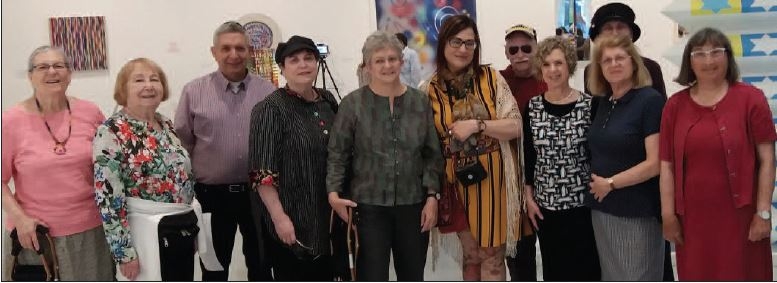A Museum Round the Corner
ESRA Rehovot club recently visited the Yaacov Agam Museum of Art in Rishon LeZion. The museum was opened in the fall of 2017 and is dedicated to the artist, who was born there in 1928. The forecourt has twenty multicolored pillars, each with a different geometric design – it is dedicated to Agam's late wife Clila. Inside the museum there are nine more pillars, one of which is between two mirrors, so that looking either up or down you see the column repeating ad infinitum – a vertigo-inducing experience.
After depositing our bags in lockers and collecting museum chairs, we were greeted by Dr. Avital Heyman, an art historian, who gave us a guided tour of the exhibit. At the entrance to the main hall she pointed out a small hologram picture of Agam framed by a heart, indicating his love for art and his wish that we will love it too.
We then viewed a short movie about the production and assembly of the columns at the entrance to the museum, and Dr. Heyman demonstrated a number of the kinetic pictures and sculptures. For this she donned cotton gloves to protect the exhibits, and turned them while explaining what Agam had been thinking when he made them. At the end of the tour she encouraged us to see the rest of the exhibit. There are six interactive works where by touching the picture you can change what you are seeing. One, Touch Image of Sound Movement, allows you to play music by touching different dots on a screen.
In addition to demonstrating the kinetic artworks on display, Dr. Heyman told us the fascinating life story of Agam. He was born Jacob Gipstein, one of a number of children born to a rabbi, and Judaism always influenced his art. For example, his choice of abstract art was partially due to the prohibition of graven images. He also makes use of Jewish-Kabbalistic iconography that he turns into abstract images. Many of his works feature opposites that merge, in keeping with the thesis-antithesis-synthesis dialectic. One example is a large revolving painting called Beyond, one side of which has a black background and the other a white one.
As a youngster, he studied with various religious tutors at a synagogue, because there was no local religious school. In 1940 he began to paint, influenced by Irving Stone's book Lust for Life. In 1945, he was jailed for eight months by the British administration on suspicion of belonging to the underground. He relates that he taught painting to the prisoners while incarcerated. He studied at the Bezalel School in Jerusalem just before the establishment of Israel. At the urging of his teacher Mordechai Ardon, he went to study in Zurich in 1949, where he learned the use of color with Johannes Itten, and encountered the constructivist art theories of the Bauhaus school. In 1951 he moved to Paris and developed ties with the city's Surrealist artists. At first he earned a living teaching at a seminary run by the Jewish Agency. In 1953 he created Polyphonic Pictures (later called Agamograms), kinetic works that change with the shifting perspective of the viewer. In 1967 he produced his first kinetic sculptures, and in 1986 began using stainless steel. In 1996 he won the UNESCO Education Prize, acknowledging the unique program he designed for early childhood visual education.
The museum has artwork that was previously in other museums and other pieces that were created for the museum. It will in the future receive more artwork from both private and public collections. Dr. Heyman demonstrated a number of kinetic sculptures and Agamograms, the raised pictures that change perspective as the viewer or object moves in space. One of the stainless steel sculptures, Floating Triangle, can be viewed both by its shadow and by its actual sculpture while being moved. The Agamogram, Beyond, can be seen as day and night, but since each side is also divided into two pictures, the sensation is more complicated than just two possibilities. Dr. Heyman's explanations added depth to the visual experience of viewing the artwork and how it changed as it moved.
The unanimous consensus of the participants was of a successful and engaging tour.
The Yaacov Agam Museum of Art (YAMA) is at 1 Meishar Street, Rishon LeZion. To arrange a tour in English, call 03 555 5900.









Comments